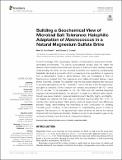Files in this item
Building a geochemical view of microbial salt tolerance : halophilic adaptation of Marinococcus in a natural magnesium sulfate brine
Item metadata
| dc.contributor.author | Fox-Powell, Mark G. | |
| dc.contributor.author | Cockell, Charles S. | |
| dc.date.accessioned | 2018-04-17T13:30:09Z | |
| dc.date.available | 2018-04-17T13:30:09Z | |
| dc.date.issued | 2018-04-16 | |
| dc.identifier | 252839082 | |
| dc.identifier | 4c3c0ee2-d5bb-4b1e-a8d6-900d4e48ecf3 | |
| dc.identifier | 85045741015 | |
| dc.identifier | 000430095800002 | |
| dc.identifier.citation | Fox-Powell , M G & Cockell , C S 2018 , ' Building a geochemical view of microbial salt tolerance : halophilic adaptation of Marinococcus in a natural magnesium sulfate brine ' , Frontiers in Microbiology , vol. 9 , 739 . https://doi.org/10.3389/fmicb.2018.00739 | en |
| dc.identifier.issn | 1664-302X | |
| dc.identifier.other | Bibtex: urn:d2ca42eae92f6d387382688b0a88f3df | |
| dc.identifier.uri | https://hdl.handle.net/10023/13152 | |
| dc.description | This study was conducted with support from the Science and Technology Facilities Council (STFC), grant no. ST/M001261/1. | en |
| dc.description.abstract | Current knowledge of life in hypersaline habitats is mostly limited to sodium and chloride-dominated environments. This narrow compositional window does not reflect the diversity of brine environments that exist naturally on Earth and other planetary bodies. Understanding the limits of the microbial biosphere and predicting extraterrestrial habitability demands a systematic effort to characterize ionic specificities of organisms from a representative range of saline habitats. Here, we investigated a strain of Marinococcus isolated from the magnesium and sulfate-dominated Basque Lakes (British Columbia, Canada). This organism was the sole isolate obtained after exposure to exceptionally high levels of Mg2+ and SO42- ions (2.369 and 2.840 M, respectively), and grew at extremes of ionic strength not normally encountered in Na+/Cl- brines (12.141 mol liter-1). Its association at the 16S rDNA level with bacterial halophiles suggests that ancestral halophily has allowed it to adapt to a different saline habitat. Growth was demonstrated in media dominated by NaCl, Na2SO4, MgCl2, and MgSO4, yet despite this plasticity the strain was still restricted; requiring either Na+ or Cl- to maintain short doubling times. Water activity could not explain growth rate differences between media, demonstrating the importance of ionic composition for dictating microbial growth windows. A new framework for understanding growth in brines is required, that accounts for the geochemical history of brines as well as the various stresses that ions impose on microbes. Studies such as this are required to gain a truly universal understanding of the limits of biological ion tolerance. | |
| dc.format.extent | 10 | |
| dc.format.extent | 767183 | |
| dc.language.iso | eng | |
| dc.relation.ispartof | Frontiers in Microbiology | en |
| dc.subject | Brine | en |
| dc.subject | Habitability | en |
| dc.subject | Marinococcus | en |
| dc.subject | Halophile | en |
| dc.subject | Magnesium sulphate | en |
| dc.subject | GE Environmental Sciences | en |
| dc.subject | QE Geology | en |
| dc.subject | QD Chemistry | en |
| dc.subject | QR Microbiology | en |
| dc.subject | NDAS | en |
| dc.subject.lcc | GE | en |
| dc.subject.lcc | QE | en |
| dc.subject.lcc | QD | en |
| dc.subject.lcc | QR | en |
| dc.title | Building a geochemical view of microbial salt tolerance : halophilic adaptation of Marinococcus in a natural magnesium sulfate brine | en |
| dc.type | Journal article | en |
| dc.contributor.institution | University of St Andrews. School of Earth & Environmental Sciences | en |
| dc.contributor.institution | University of St Andrews. St Andrews Centre for Exoplanet Science | en |
| dc.identifier.doi | 10.3389/fmicb.2018.00739 | |
| dc.description.status | Peer reviewed | en |
This item appears in the following Collection(s)
Items in the St Andrews Research Repository are protected by copyright, with all rights reserved, unless otherwise indicated.

